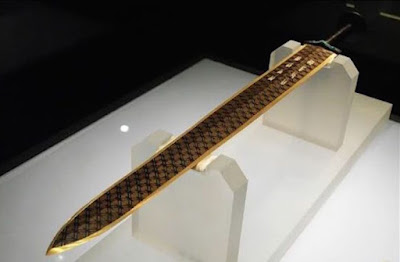Week 3 Robotics + Art
Both of this week's readings talk about the impact of the industrial age on art, science, and technology. Douglas Davis argued that "the work of art in the age of digital reproduction is physically and formally chameleon and there is no longer a clear conceptual distinction between original and reproduction in virtually any medium". In Walter Benjamin's "The Work of Art in the age of Mechanical Reproduction", he stated that even the most perfect reproduction of a work of art is lacking its presence in time and space. The mass production of art removes the creativity and originality from an artwork. This explains why a collector would spend millions of dollars for an auction to win an original artwork rather than purchasing its reproduction. Moreover, I want to point out that sometimes the modern industrial technologies are unable to reproduce ancient technologies. The Sword of Goujian, an archaeological artifact of the Spring and Autumn period (771 to 403BC), was found in 1965 in Hubei, China. The sword is found to have zero rusting throughout 2500 years, which cannot be achieved by modern technologies. Scientists have no idea whether the grains on the sword surface were formed by chemical processes or physical processes.
BMW assembly line
The sword of Goujian
This week, I focused on the topic of robotics and art. In the last part of the online lecture, professor Machiko Kusahara introduced the differences in robotics designs among different cultures. She stated that, in Japan, engineers tend to make robots humanoid. The size of the robots should smaller than human beings and each robot has a friendly face. This is also true in the Japanese cartoon. This is because robots in Japan are more likely designed to serve people and the designers do not want robots to scare people.
A robot wants to shake hands with a person
However, in western cultures, robots are usually used in mass production. Robots are more likely to appear in terms of huge machine arms that are used in the assembly line. They are usually linked to high technologies. Professor Vesna gave an example of how Ford uses robots in the assembly line to manufacture vehicles. Similarly, in many American movies such as Transformers and Ironman, the robots usually have the super power.
Before this week's lecture, I know both Japan and some western countries design high-tech robots. However, I have not realized how different they are in different cultures. In the future, due to the global cultural interaction, I believe the gap will be smaller.
References
Benjamin, Walter. The Work of Art in the age of Mechanical Reproduction. London: Penguin, 2008. Print.
Chang, Stephanie. "2500-Year-Old Chinese Sword Still Looks and Cuts Like New." My Modern Met, 08 Dec. 2016, mymodernmet.com/sword-of-goujian/#.WEwb2Ye-Yx1.pinterest. Accessed 23 April 2017.
Davis, Douglas. "The Work of Art in the Age of Digital Reproduction." Leonardo, Vol.28, No.5, 1995, pp. 381-386, www.jstor.org/stable/1576221?seq=1#page_scan_tab_contents. Accessed 23 April 2017.
Vesna, Victoria. "Robotics pt2." YouTube, uploaded by Uconlineprogram, 15 April 2012, www.youtube.com/watch?v=oAZ8bo9T_Pk .
Davis, Douglas. "The Work of Art in the Age of Digital Reproduction." Leonardo, Vol.28, No.5, 1995, pp. 381-386, www.jstor.org/stable/1576221?seq=1#page_scan_tab_contents. Accessed 23 April 2017.
Kusahara, Machiko. "Robotics MachikoKusahara 1." YouTube, uploaded by Uconlineprogram, 14 April 2012, www.youtube.com/watch?v=xQZ_sy-mdEU.
Vesna, Victoria. "Robotics pt2." YouTube, uploaded by Uconlineprogram, 15 April 2012, www.youtube.com/watch?v=oAZ8bo9T_Pk .




Comments
Post a Comment